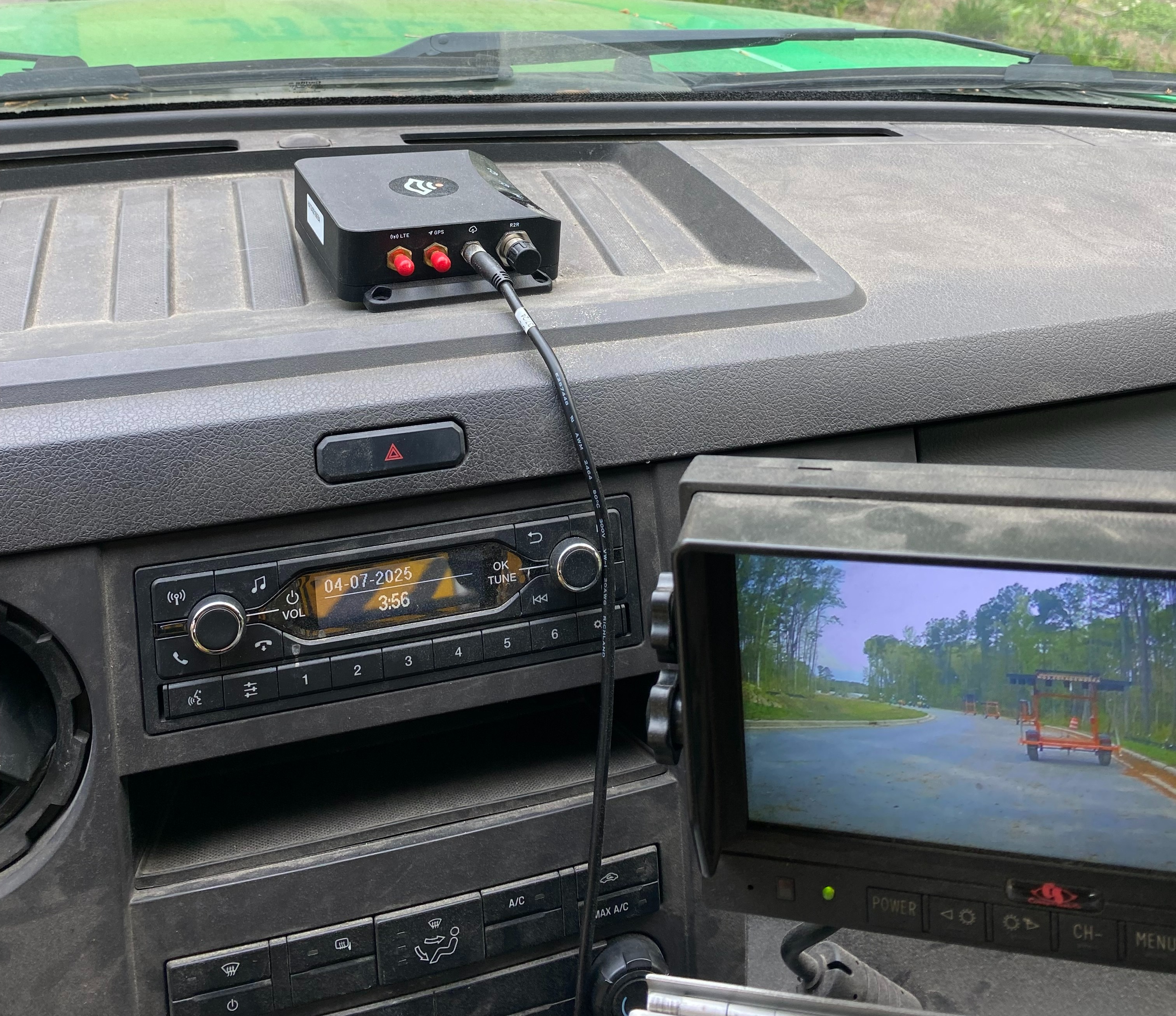Delivering Safer Work Zones, One Digital Alert at a Time
Imagine a world in which no road construction workers or motorists are senselessly injured or lose their lives because of work zone crashes. No more holidays celebrated without friends or loved ones, no more life-altering injuries, no more communities devastated by tragedy.
Now imagine a world in which motorists can also anticipate and plan for every road construction project. No more white-knuckle gridlock, blaring bursts of high-pitched horns or fear of reckless drivers. Thanks to cloud-based, live GPS data alerts, motorists can pre-plan their routes with the confidence they’ll arrive safely – and on time.
Balfour Beatty teammates are making both scenarios possible through a cutting-edge digital technology, Safety Cloud® by HAAS Alert. Safety Cloud® is the world’s largest vehicle-to-everything (V2X) communication network that delivers real-time digital alerts directly to motorists within a one-mile radius. These alerts warn motorists of emergency vehicles and crews, work zones and other hazards, allowing them more time to slow down, move over and make safer maneuvers.
In 2024, Balfour Beatty began utilizing Safety Cloud® on three projects in North Carolina: U.S. 70 James City, U.S. 70 Havelock Bypass and I-295 Fayetteville Outer Loop. By inputting work zone updates into Safety Cloud® such as lane shifts and closures, detours, temporary traffic signals and more, our teams are cultivating critical and timely public awareness that is engineering out risk and resulting in safer roadways for all.
From October 2024 through March 31, 2025, Balfour Beatty has sent 300 Safety Cloud® alerts to an impressive 63,910 nearby motorists across all three projects—proof of the technology’s extensive reach to foster greater motorist situational awareness. The goal of Safety Cloud®, and other controls and technologies Balfour Beatty has implemented, is to address the growing crisis of roadway fatalities impacting both motorists and road workers.
Unlocking the Cloud
 At each of the three jobsites, Balfour Beatty has installed Safety Cloud® transponders on our eastbound and westbound Truck-Mounted Attenuator or TMA trucks, colloquially known as “crash trucks.” The GPS-enabled transponders communicate a warning light status from the connected vehicle to Safety Cloud® so that digital alerts can be sent through various alerting partners, including Apple Maps and Waze; manufacturer-specific in-vehicle notification systems for Chrysler, Dodge, Ram and Jeep; and The Allstate Corporation’s app, Drivewyze®.
At each of the three jobsites, Balfour Beatty has installed Safety Cloud® transponders on our eastbound and westbound Truck-Mounted Attenuator or TMA trucks, colloquially known as “crash trucks.” The GPS-enabled transponders communicate a warning light status from the connected vehicle to Safety Cloud® so that digital alerts can be sent through various alerting partners, including Apple Maps and Waze; manufacturer-specific in-vehicle notification systems for Chrysler, Dodge, Ram and Jeep; and The Allstate Corporation’s app, Drivewyze®.
 Assistant Project Manager Brandon Cline manages Safety Cloud® for the James City project team and praises how quickly and seamlessly the program enables precise updates for the traveling public.
Assistant Project Manager Brandon Cline manages Safety Cloud® for the James City project team and praises how quickly and seamlessly the program enables precise updates for the traveling public.
Creating a road closure alert is as simple as moving two pins on a digital map,” says Brandon, “and the public receives the notification in just 30 seconds.”
One of Brandon’s favorite features in Safety Cloud® is the ability to schedule activities in advance through the program’s date selection option. Because the North Carolina Department of Transportation (NCDOT) requires a seven-day advance notification for all main road closures and 24 hours for all service road closures, our use of Safety Cloud® aligns with the proactive planning our teams already perform.

“Even if a motorist missed the sign that tells them the right lane is closed ahead, Safety Cloud® alerts give us one more shot at getting their attention prior to the point where traffic has to merge,” adds Josh Sommer, project manager, who is overseeing the James City project.
Reducing Distractions
Distracted driving is a serious safety hazard everywhere, but perhaps nowhere more so than in active work zones, where dynamic traffic patterns, variable speed limits and the presence of heavy equipment and vulnerable workers require drivers’ undivided attention.
On major thoroughfares such as I-70 and I-295 where Balfour Beatty has deployed Safety Cloud®, motorists are often traveling many hours and miles away from home and are therefore more likely to be unaware of work zones. I-70, for example, is one of the primary east-west corridors across eastern North Carolina, is extensively used for moving freight, provides vital connections to two military bases and is the main thoroughfare to the state’s Crystal Coast beaches.
This lack of familiarity is especially dangerous in work zones, which often contain intricate traffic pattern shifts such as added merge points, narrowed rights-of-way and more that may create confusion or frustration, causing motorists to change lanes too quickly or hit their brakes unexpectedly.
“Driving distractions come in many shapes and forms, and lack of roadway familiarity can absolutely be a significant cause,” attests Eric Yates, environmental, safety and health (EH&S) manager in the Southeast. “Drivers may divert their attention to new landscapes and landmarks such as rest stops or search their mobile devices for directions without pulling over, causing them to miss critical road signs like reduced speed limits or lane merges. Safety Cloud® gives us another tool in our toolbox to make drivers aware of work zone activities and conditions in real-time.”
Combatting Complacency
According to Construction Manager Jason Sikora who oversees Safety Cloud® on the I-295 Fayetteville Outer Loop project, motorist complacency in work zones is a problem of equal proportion.
Although the North Carolina Department of Transportation has installed ample signage along the entire 28-mile stretch of interstate under construction, Jason has found that motorists are more prone to ignore signage when work zones span many miles. While the barrier walls erected on both sides of the highway are an effective method of “positive protection” against work zone intrusions, they leave motorists with little room for error.
Balfour Beatty’s 4.3-mile segment is located at the northernmost end of the work zone, northbound traffic is especially prone to complacency having traveled over 20 miles through altered traffic patterns replete with signage.
Southbound traffic presents different challenges due to motorists’ lack of acclimation to rapidly changing conditions. Many motorists enter our work zone at the same speeds they have been traveling, recklessly failing to heed reduced limits. Additionally, there are two entrance ramps that merge onto I-295 southbound within our project limits that have less pre-work zone signage, rendering the Safety Cloud® alerts even more important for these motorists.
 “Traffic management at Fayetteville Outer Loop is really a double-edged sword,” describes Jason. “Safety Cloud® gives us the advantage of reaching drivers in a way that is direct and personal. They receive updates, direction and advance warnings in a timeframe that allows them to process the information but not so far in advance that they forget or ignore it.”
“Traffic management at Fayetteville Outer Loop is really a double-edged sword,” describes Jason. “Safety Cloud® gives us the advantage of reaching drivers in a way that is direct and personal. They receive updates, direction and advance warnings in a timeframe that allows them to process the information but not so far in advance that they forget or ignore it.”
Our Fayetteville Outer Loop project team has already witnessed the benefits of Safety Cloud®, with a greater percentage of motorists abiding by temporary traffic control (TTC) measures.
“I really appreciate all that Safety Cloud® allows us to do to keep everyone informed and safe as they travel, which helps us in keeping our workforce safe as they build our nation’s roadways and bridges,” praises Jason.
Creating Safer Roadways for All
Work zones play a key role in maintaining and upgrading our nation's infrastructure, but they pose serious and potentially fatal dangers for road construction workers and motorists alike. These dangers, according to a 2024 Associated General Contractors of America's (AGC) study, are on an alarming rise, with 64% of highway contractors reporting work zone crashes over the last year and 97% of highway contractors reporting that the risk of highway work zone crashes is as great or greater than a year ago.
In his 2022 remarks on national roadway safety strategy, former U.S. Transportation Secretary, USDOT, Pete Buttigieg aptly summarized the critical imperative before us to make our roadways and work zones safer: “It's as if we were living through a war... When it comes to roadway deaths, we have a crisis that’s urgent, unacceptable - and preventable.”
At Balfour Beatty, a foundational tenet of our Zero Harm culture is that no loss of life, or potential for loss of life, is acceptable. This core belief also extends to injuries of all magnitudes. No matter the scope or type of work performed, we seek to first eliminate risks. Where risks cannot be fully eliminated, tools like Safety Cloud® empower our teams to mitigate those risks on behalf of our workforce and the public.
“We’re keeping our foot on the gas to create safer work zones,” emphasizes Eric. “Working with our industry partners and organizations like the Carolinas Associated General Contractors (CAGC), we are exploring every avenue and tool available to keep people safe.”
But it will take more than cutting-edge technologies to achieve Zero Harm on our roadways. It will take embracing our individual responsibilities as motorists and collective responsibility as an industry and society. It will take a total transformation in our mentality about risk, beginning with the belief that no human life is expendable.